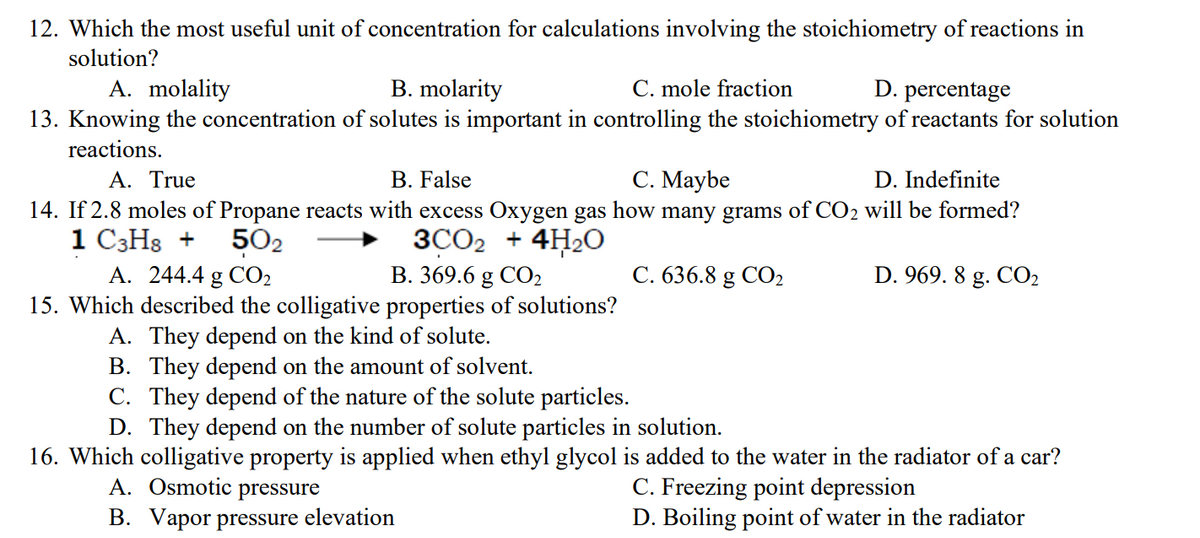12. Which the most useful unit of concentration for calculations involving the stoichiometry of reactions in solution? A. molality B. molarity C. mole fraction D. percentage 13. Knowing the concentration of solutes is important in controlling the stoichiometry of reactants for solution reactions. A. True B. False C. Maybe D. Indefinite 14. If 2.8 moles of Propane reacts with excess Oxygen gas how many grams of CO₂ will be formed? 1 C3H8 + 50₂ 3CO₂ + 4H₂O A. 244.4 g CO2 B. 369.6 g CO₂ C. 636.8 g CO2 D. 969.8 g. CO₂
12. Which the most useful unit of concentration for calculations involving the stoichiometry of reactions in solution? A. molality B. molarity C. mole fraction D. percentage 13. Knowing the concentration of solutes is important in controlling the stoichiometry of reactants for solution reactions. A. True B. False C. Maybe D. Indefinite 14. If 2.8 moles of Propane reacts with excess Oxygen gas how many grams of CO₂ will be formed? 1 C3H8 + 50₂ 3CO₂ + 4H₂O A. 244.4 g CO2 B. 369.6 g CO₂ C. 636.8 g CO2 D. 969.8 g. CO₂
Introductory Chemistry: An Active Learning Approach
6th Edition
ISBN:9781305079250
Author:Mark S. Cracolice, Ed Peters
Publisher:Mark S. Cracolice, Ed Peters
Chapter16: Solutions
Section: Chapter Questions
Problem 14E
Related questions
Question
Please help me answer these subunits!

Transcribed Image Text:12. Which the most useful unit of concentration for calculations involving the stoichiometry of reactions in
solution?
A. molality
B. molarity
C. mole fraction
D. percentage
13. Knowing the concentration of solutes is important in controlling the stoichiometry of reactants for solution
reactions.
A. True
B. False
C. Maybe
D. Indefinite
14. If 2.8 moles of Propane reacts with excess Oxygen gas how many grams of CO2 will be formed?
1 C3H8 +
50₂
3CO2 + 4H₂O
A. 244.4 g CO₂
B. 369.6 g CO₂
C. 636.8 g CO₂
D. 969.8 g. CO₂
15. Which described the colligative properties of solutions?
A. They depend on the kind of solute.
B. They depend on the amount of solvent.
C. They depend of the nature of the solute particles.
D. They depend on the number of solute particles in solution.
16. Which colligative property is applied when ethyl glycol is added to the water in the radiator of a car?
A. Osmotic pressure
C. Freezing point depression
B. Vapor pressure elevation
D. Boiling point of water in the radiator
Expert Solution
This question has been solved!
Explore an expertly crafted, step-by-step solution for a thorough understanding of key concepts.
Step by step
Solved in 2 steps

Knowledge Booster
Learn more about
Need a deep-dive on the concept behind this application? Look no further. Learn more about this topic, chemistry and related others by exploring similar questions and additional content below.Recommended textbooks for you

Introductory Chemistry: An Active Learning Approa…
Chemistry
ISBN:
9781305079250
Author:
Mark S. Cracolice, Ed Peters
Publisher:
Cengage Learning

EBK A SMALL SCALE APPROACH TO ORGANIC L
Chemistry
ISBN:
9781305446021
Author:
Lampman
Publisher:
CENGAGE LEARNING - CONSIGNMENT

Principles of Modern Chemistry
Chemistry
ISBN:
9781305079113
Author:
David W. Oxtoby, H. Pat Gillis, Laurie J. Butler
Publisher:
Cengage Learning

Introductory Chemistry: An Active Learning Approa…
Chemistry
ISBN:
9781305079250
Author:
Mark S. Cracolice, Ed Peters
Publisher:
Cengage Learning

EBK A SMALL SCALE APPROACH TO ORGANIC L
Chemistry
ISBN:
9781305446021
Author:
Lampman
Publisher:
CENGAGE LEARNING - CONSIGNMENT

Principles of Modern Chemistry
Chemistry
ISBN:
9781305079113
Author:
David W. Oxtoby, H. Pat Gillis, Laurie J. Butler
Publisher:
Cengage Learning

Chemistry: An Atoms First Approach
Chemistry
ISBN:
9781305079243
Author:
Steven S. Zumdahl, Susan A. Zumdahl
Publisher:
Cengage Learning

Chemistry: The Molecular Science
Chemistry
ISBN:
9781285199047
Author:
John W. Moore, Conrad L. Stanitski
Publisher:
Cengage Learning

Chemistry: Principles and Reactions
Chemistry
ISBN:
9781305079373
Author:
William L. Masterton, Cecile N. Hurley
Publisher:
Cengage Learning